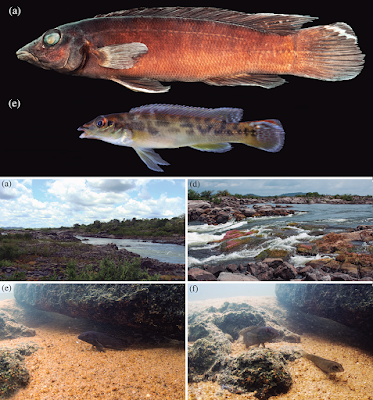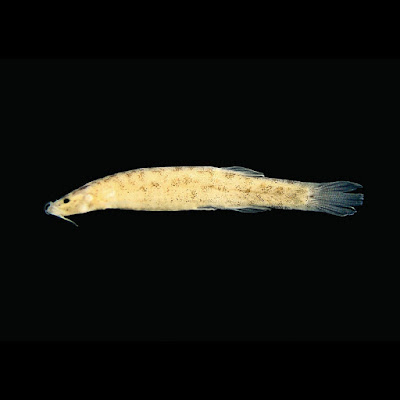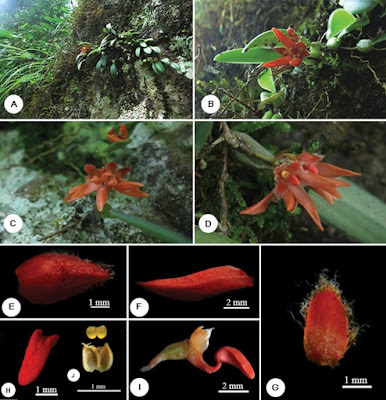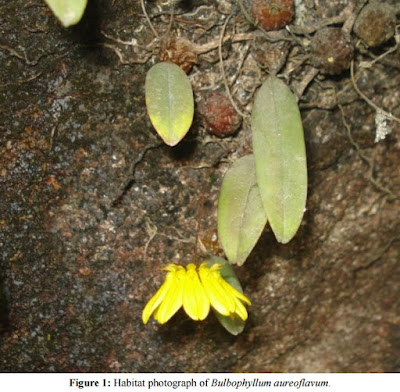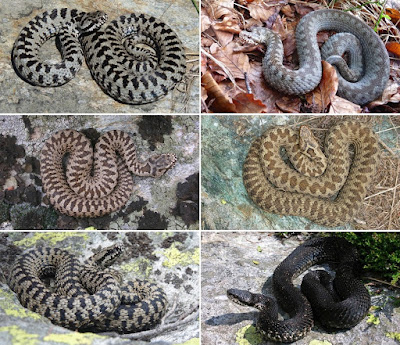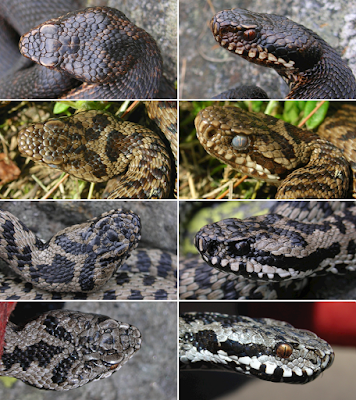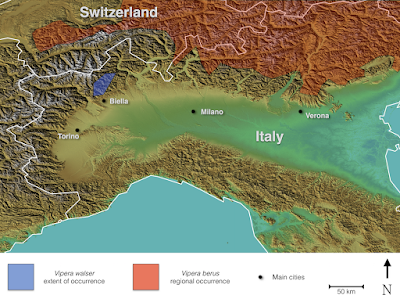[Most Recent Entries] [Calendar View]
Friday, July 1st, 2016
| Time | Event | ||||||||
| 2:40a | [Ichthyology • 2016] Teleocichla preta • A New Species of Cichlid (Teleostei: Cichlidae) from the Rio Xingu Basin in Brazil
Abstract Teleocichla preta nov. sp. inhabits the rapids along the Rio Xingu and lower portion of the Rio Iriri. It is the largest species in the genus, reaching 121·3 mm standard length (LS) while others do not reach more than 87·8 mm LS. Teleocichla preta is distinguished from all other species of Teleocichla by the unique blackish (in live specimens) or dark brown (preserved specimens) overall colouration of the body, which masks the faint vertical bars or zig-zag pattern of blotches on the flanks. Teleocichla preta also has a deeper body and a deep laterally compressed caudal peduncle, unlike any other congener, as well as a stout lower pharyngeal tooth plate bearing molariform teeth on its median area. Keywords: Amazon basin; durophagy; endemism; rapids; rheophilic species; taxonomy Teleocichla preta nov. sp. Teleocichla PR Zuanon, 1999: 48 (diagnosis, schematic illustration and aspects of natural history of the species). Teleocichla sp. Xingu II (or Schwarzel Teleocichla) Stawikowski & Werner, 2004: 247 (comments on distinctive characteristics and ecology of the species, photographs of live specimens). Teleocichla sp. preta Arbour & López-Fernández, 2013: 4. Arbour & López-Fernández, 2014: 7 (inclusion of the species in biomechanical analyses in the context of the Crenicichla clade and of other Neotropical lineages of Cichlidae, respectively). Distribution: Teleocichla preta is known from the Rio Xingu between Cachoeira Chadasinho upstream of São Félix do Xingu and Cachoeira do Jericoá at Volta Grande do Xingu downstream of Altamira, Pará State. The species is also known from the lower portion of the Rio Iriri, the largest tributary of the Rio Xingu (Fig. 4).
Habitat and natural history: In the region of Volta Grande do Xingu and the lower Rio Iriri, specimens of T. preta were collected in moderate to fast, shallow rapids [Fig. 5(a)–(d)], with clear water and the riverbed composed mainly of large rocks and little accumulated sediment [Fig. 5(e), (f)]. During underwater exploration by snorkelling, individuals of T. preta were observed performing short excursions out of their rocky hideouts, moving alone amidst small rocks and in crevices of large rocks (J. Zuanon. and H. R. Varella, pers. obs). Etymology: The specific epithet preta, an adjective of the Portuguese language that means black, refers to the diagnostic dark overall colouration of the body and to the previous denominations for the species in the scientific and aquarium literature, as well as among fishermen of the Rio Xingu. Noun in apposition. H. R. Varella, J. Zuanon, S. O. Kullander and H. López-Fernández. 2016. Teleocichla preta, A New Species of Cichlid from the Rio Xingu Basin in Brazil (Teleostei: Cichlidae). Journal of Fish Biology. DOI: 10.1111/jfb.13053 | ||||||||
| 3:31a | [Ichthyology • 2011] Stenolicmus ix • A New Species of Sand-dwelling Catfish of the genus Stenolicmus (Siluriformes; Trichomycteridae) from Igarapé Curuá, left tributary of the Rio Amazonas, Pará, Brazil
Abstract Stenolicmus ix, new species, is described from Igarapé Curuá, left tributary of the Rio Amazonas, Pará, Brazil. It can be distinguished from S. sarmientoi by the length of the nasal barbels that reach the base of the first opercular odontodes; length of the maxillary barbels that reach the posterior margin of the opercular odontode plate; seven well-developed opercular odontodes; seven well-developed interopercular odontodes; color pattern of the dorsal region of trunk composed of agglomerated chromatophores forming circular patches twice the diameter of the eye; proportionally large eyes, 11.8% HL; caudal peduncle tall, 11.6% SL, without dark bar at base of the caudal fin; length of the head proportionately larger, 17.9% SL; unbranched rays of caudal fin reaching distal margin of fin. Comparisons with other Sarcoglanidinae and Trichomycteridae are presented. Some comments on the systematics and phylogenetic relationships of the group are made. Keywords: New catfish; Sarcoglanidinae; lower Amazon basin Wolmar Benjamin Wosiacki, Daniel Pires Coutinho and Luciano Fogaça de Assis Montag. 2011. Description of A New Species of Sand-dwelling Catfish of the genus Stenolicmus (Siluriformes; Trichomycteridae). Zootaxa. Jaguar-like species of catfish discovered in the Amazon | ||||||||
| 9:51a | [Botany • 2016] Bulbophyllum pingnanense • A New Species (Orchidaceae, Epidendroideae, Dendrobiinae) from Fujian, China
Abstract A new orchid species, Bulbophyllum pingnanense, is described and illustrated from Fujian, China. It is similar to B. brevipedunculatum and B. albociliatum in vegetative and floral morphology, but it can be distinguished from B. brevipedunculatum by having a longer dorsal sepal with longer white ciliate on margin, longer and lanceolate lateral sepals, and a glabrous lip. It can be distinguished from B. albociliatum by having a shorter inflorescence, and a longer dorsal sepal. Keywords: Bulbophyllum, Eastern China, Fujian, Orchidaceae Taxonomy Bulbophyllum pingnanense J.F. Liu, S.R. Lan & Y.C. Liang, sp. nov. urn:lsid:ipni.org:names:77155742-1 Type: China. Fujian: Pingnan County, Shuangxi Town, on rock along Yuanyan River, 800–900 m, 27°01'N, 119°05'E, 23 June 2013, J.F. Liu 201312 (holotype: FAFU!; isotype: NOCC!). Diagnosis: Bulbophyllum pingnanense is similar to B. brevipedunculatum T.C. Hsu & S.W. Chung and B. albociliatum (T.S. Liu & H.Y. Su) K. Nackejima. It differs from B. brevipedunculatum by having a longer dorsal sepal with either an obtuse or an acute apex and longer white ciliate on margins; longer and lanceolate lateral sepals; and glabrous lip. It can be distinguished from B. albociliatum by its shorter inflorescence, a longer dorsal sepal with either an obtuse or an acute apex. Etymology: The species epithet refers to Pingnan County where this new species was found. Distribution and habitat Bulbophyllum pingnanense is so far only known within Pingnan, Fujian, China (Fig. 3). It is epiphytic on steep rock in the edge of evergreen coniferous and broad-leaved mixed forest, which is mainly composed of Castanopsis eyrei (Champ. ex Benth.) Hutch. (Fagaceae), Cunninghamia lanceolata (Lamb.) Hook. (Taxodiaceae). Other orchids, Amitostigma gracile (Bl.) Schltr., Pholidota cantonensis Rolfe, Cymbidium floribundum Lindl. and Pleione formosana Hayata, were found growing nearby this new species. Phenology: Flowering from June to July. Conservation status: Bulbophyllum pingnanense is known only from the type locality, and only one population of ca. 3000 individual plants was discovered in a small area of ca. 0.002 km2 during two years of botanical surveys. Based on the extent of occurrence estimated to be less than 100 km2 (CR B1) and the area of occupancy less than 10 km2 (CR B2), species existing at a single location (CR B1a + B2a), B. pingnanense is assigned a preliminary status of Critically Endangered (CR B1a + B2a) according to the IUCN Categories and Criteria (IUCN 2012). In addition, the plants of Bulbophyllum are used as herbal medicine in the locality. It is possible that B. pingnanense might also be collected for using as herbal medicine. Therefore, immediate conservation strategy should be taken. Jiangfeng Liu, Si-Ren Lan, Bi-Zhu He and Yi-Chi Liang. 2016. Bulbophyllum pingnanense (Orchidaceae, Epidendroideae, Dendrobiinae), A New Species from Fujian, China. PhytoKeys. 65: 107-112. DOI: 10.3897/phytokeys.65.8254 | ||||||||
| 10:08a | [Botany • 2013] Bulbophyllum aureoflavum • A New Orchid of the Genus Bulbophyllum (Orchidaceae) from Western Ghats of Southern India
Abstract Bulbophyllum aureoflavum, a new orchid from Western Ghats of southern India, is described and illustrated. The new species, Bulbophyllum aureoflavum, is rare and known presently only from the type locality in southern Western Ghats. This species is related to B. elegantulum and B. fischeri, but differs by having a thick rhizome, subglobose pseudopbulb, bendant filiform scape, and a light golden yellowish, glabrous flower. Keywords: Bulbophyllum aureoflavum; new species; pantropical; taxonomy Diagnosis: The species can be differentiated from its allied species only when flowering during the dry months of May and June. The species is easily overlooked because its small bulbs and leaves are similar to those of Bulbophyllum elegantulum J. J. Sm. and B. fischeri Seidenf. Bulbophyllum aureoflavum which can be distinguished by its long, filiform, pendent, 12-flowered scape and by its golden yellowish, elliptic, connate, glabrous, and lateral sepals. Haec species Bulbophyllum elegantulum et B. fischeri similes, rhizome crassis, pseudobulbis subglobosis, scapus filiformis, flores aureo-flavo, sepalum elongato-ovatum, labello profunde sulcate differt. Distribution: Endemic to the Munnar-Devicolam Range of Western Ghats, Kerala State, India, growing on shaded rocks at about 1200m. It is known only from the type locality. Remarks: The present study noticed only 15 well-separated clumps, each of no more than 100 bulbs on shaded rocks next to the road from Devicolam to Poopara. S. Karuppusamy and V. Ravichandran. 2013. A New Orchid of the Genus Bulbophyllum (Orchidaceae) from Western Ghats of Southern India. TAPROBANICA. 5(2); 120-123. DOI: 10.4038/tapro.v5i2.6285 | ||||||||
| 10:49a | [Herpetology • 2016] Vipera walser • A New Vertebrate for Europe: The Discovery of A Range-restricted Relict Viper in the western Italian Alps
Abstract We describe Vipera walser, a new viper species from the north-western Italian Alps. Despite an overall morphological resemblance with Vipera berus, the new species is remarkably distinct genetically from both V. berus and other vipers occurring in western Europe and shows closer affinities to species occurring only in the Caucasus. Morphologically, the new species appear to be more similar to V. berus than to its closest relatives occurring in the Caucasus, but can be readily distinguished in most cases by a combination of meristic features as confirmed by discriminant analysis. The extant population shows a very low genetic variability measured with mitochondrial markers, suggesting that the taxon has suffered a serious population reduction/bottleneck in the past. The species is extremely range-restricted (less than 500 km2) and occurs only in two disjunct sites within the high rainfall valleys of the Alps north of Biella. This new species should be classified as globally ‘endangered’ due to its small and fragmented range, and an inferred population decline. The main near-future threats to the species are habitat changes associated with reduced grazing, along with persecution and collecting. Keywords: Vipers; Vipera berus; Vipera walser; reptile conservation; new species; bPTP species delimitation model; Alps; biogeography; climate change
Taxonomy Vipera walser Ghielmi, Menegon, Marsden, Laddaga & Ursenbacher sp. nov. Holotype: Adult female: MSNG34485, collected in S. Giovanni d'Andorno, on the road to Oropa in the Biella prealps, at about 1300 m a.s.l. by A. Rosazza in the summer of 1930 (Fig. 5). Paratypes: One adult male: MSNG33638M collected at Monte Rosso del Croso, on 30 August 1933. One juvenile male: MSNG33637B and one subadult male: MSNG30818C collected at Alpe Finestre by Felice Capra, respectively, on 28 July 1930 and 15 August 1928. One adult female: MSNG30818A, one subadult female: MSNG30818B, and two juvenile females: MSNG33637C and MSNG33637D collected by Felice Capra at Alpe Finestre between August 1928 and August 1939. One juvenile female: MSNG30286 collected by F. Capra at Monte Rosso del Croso on 12 September 1934; one adult female MSNG33637A collected by F. Capra at Alpe le Piane on 5 August 1937; one adult female MSNG41663 collected by A. Margiocco at Piedicavallo in September 1967. Type locality: San Giovanni d'Andorno, strada per Oropa at 1300 m a.s.l. in the Alps north of town of Biella, a subrange of the Pennine Alps, north-western Italy. Differential diagnosis: Vipera walser sp. nov. is generally similar to the species of the subgenus Pelias and can be confused with V. berus, which co-occurs on the Alps in allopatry (Fig. 6, Table 2). The species differs in a generalized higher count of cephalic scales, in particular the ones listed below (V. berus in parentheses): higher number of crown scales: 7–30, mean 17.4 (versus 4–22, mean 13.0); loreals: 4–15, mean 9.36 (versus 2–12, mean 6.72); and, to a lesser extent, perioculars: 16–23, mean 19.8 (versus 13–23, mean 18.4) (see Table 2). V. walser, in contrast to V. berus, also shows a marked tendency towards fragmentation of the cephalic large shields: the parietal scales are often completely broken down into several smaller scales: 2–14, mean 6.3 (versus 2–10, mean 2.4; see also Fig. 7). Less commonly, also the frontal scale is fragmented into smaller scales. Some individuals exhibit a dorsum of the head covered in small, irregular scales, like in V. aspis. V. walser has between 1.5 and 2 rows of subocular scales on both sides of the head in 85% of the analysed specimens (V. berus has typically one row of suboculars, with the exception of some populations in the southern Alps). The dorsal zigzag is often broken down into separate bars as in Vipera aspis (Linnaeus, 1758) or Vipera berus bosniensis (see Fig. 6). Despite the lack of a strictly diagnostic morphological character, V. walser can be readily distinguished from populations of V. berus from Central and northern Europe by a combination of several characters (e.g. the number of subocular scales, fragmentation of parietals and number of apicals). Identification based solely on observation of external morphology is less obvious if individuals of V. berus from southern Alps are considered. Despite this, discriminant analysis correctly identified individuals to species in 94% of females and 88% of males, based on a set of analysed characters (see Figs 2 and 3). The mean p-distance, based on a combined dataset of about 3000 base pairs of mitochondrial genes, between V. berus and V. walser is 5.36%. Based on our current knowledge of its distribution, Vipera walser is restricted to the Alps north of town of Biella, a subrange of the Pennine Alps, west of the river Ticino, north-western Italy (Fig. 8). Etymology: Vipera walser sp. nov. is named after, and dedicated to, the Walser people with whom it shares an extraordinary beautiful and wild area of the south-western Alps.
Conclusion The present study described and named a new viper species, V. walser, which shows strong genetic divergence and clear morphological differentiation from all other known European viper species. The new taxon occurs in a restricted area of the south-western Italian Alps and shows close affinities with the Caucasian species V. dinniki, V. darevskii and V. kaznakovi, opening unexpected and interesting biogeographic scenarios. The very small extent of occurrence of the new species implies a particularly high threat level, and thus conservation managements should be developed. The protection of its habitat, the limitation of the forest regrowth, but also the evaluation of its likely future distribution given climatic changes (for the long term) or struggle against culling (short term) are key elements to investigate. Involvement of local authorities, foundations and other stakeholders will be crucial in realizing effective protection of this species. Samuele Ghielmi, Michele Menegon, Stuart J. Marsden, Lorenzo Laddaga and Sylvain Ursenbacher. 2016. A New Vertebrate for Europe: The Discovery of A Range-restricted Relict Viper in the western Italian Alps. Journal of Zoological Systematics and Evolutionary Research. 54(3); 161–173. DOI: 10.1111/jzs.12138 |
| << Previous Day |
2016/07/01 [Calendar] |
Next Day >> |
